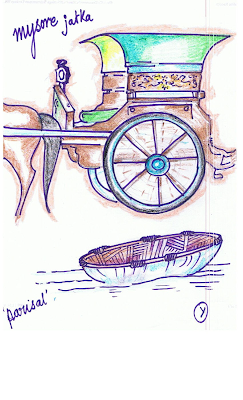Brilliance crafted in Black and Gold
LAI ROT NAM
When on a Wat visit in Thailand , you just cant miss those door and window panes- many a time, protected by an overlay of plexiglass . You can tell right away that they are precious . Not just expensive in material value alone . Precious because of the intricacy of the craft , sometimes because of the age and always because they are a labour of love and piety , offered to The Lord as a reconfirmation of Faith .
The traditional Thai decorative Art of Gold leaf inlay on Black Lacquered wood originated during the Ayutthya Period ( 14 th to 18th Century ) reaching the highpoint of creativity in 17th Century . When the capital shifted to Bangkok (Rattinakosin Era, 18th Cent ) , the art was modified with Chinese influences , while Chiang Mai , in the north , preserved the traditional Thai technique . To this day , the Chiang Mai label is assurance of the highest quality of work.
The process :
- A wooden or bamboo base is coated with multiple layers of Raq or Black Lacquer ( also called True Lacquer ), which is the sap of The Burmese Laq tree ( Melanorrhoea usitata ) and left to dry. Sometimes, when the bamboo base is delicate , cotton fabric is stuck over it for reinforcement.
- The required design is traced on to the prepared base .
- A gummy water soluble yellow paste is then applied to all areas that are required to remain black .
- Finally, one layer of lacquer is applied all over, covering everything . When it is semi dried, goldleaf is patted down over the entire surface.
- This is left to dry for whole day and then washed in cold water . All the gum, along with the gold on it , will be washed away leaving only the design gilded in gold intact . The rest of the area is black . The name Lai Rot Nam refers to this last stage when , after washing in water , the beautiful designs emerge .
Later , the decorative art was applied to all things of utility . Door and window panes and frames, bowls , boxes , furniture, walls , anything wooden could be beautified with the rich , glossy black and gold ornamentation . The goldleaf used is 99.9% pure Yellow Gold for religious items or the 97% Red Gold variety . Setting gems in the design is a later development .
Occassionally , red lacquer is used for background , but it does not give the same rich look as black does .
Silver and mother of pearl are also used in place of gold . The National Museum in Bangkok has stunning Lai Rot Nam antiques on display , which inspite of the age , remain as brilliant as they were when created .
During modern times , the technique has been used in making jewelry and souvenirs too.
(Antique Lanna bowl , Chiang Mai )
Some of the older Wats have antique lacquerware doors and windows in very good condition . Reportedly , the designs used can indicate, to informed viewers , the period and provenance of the work .
-----------






Comments